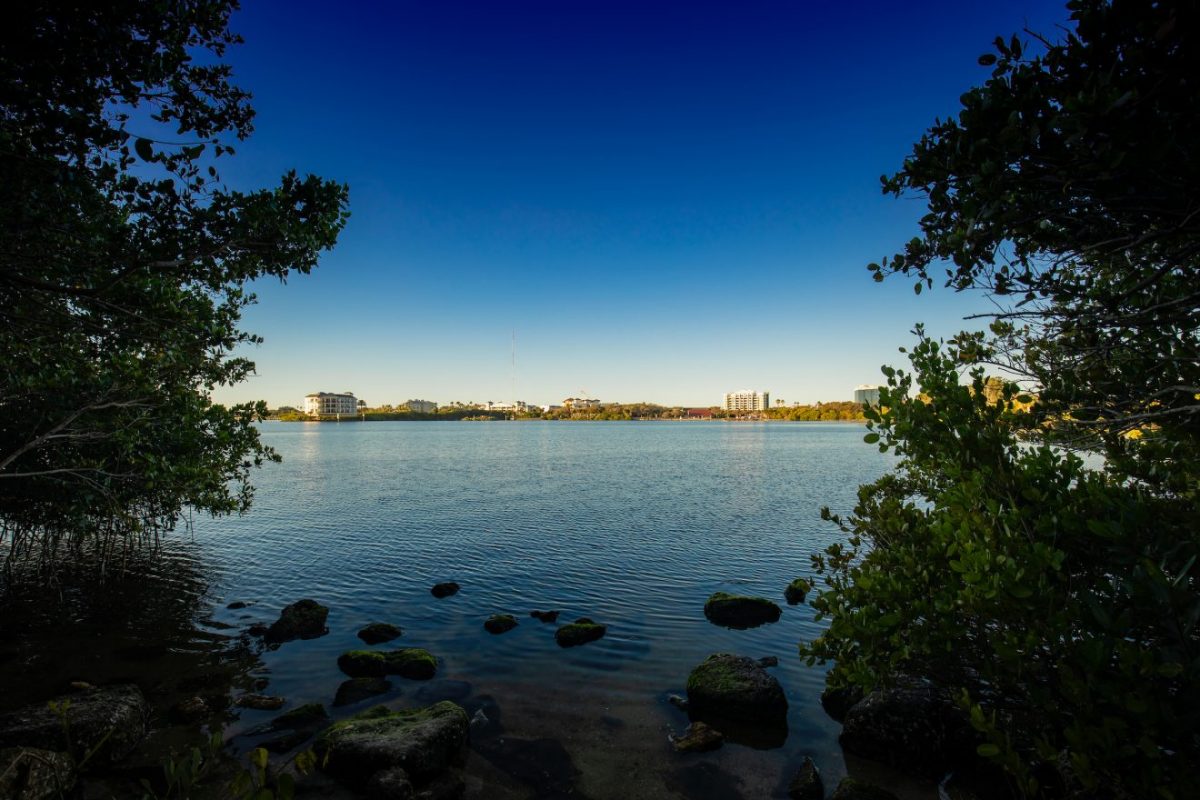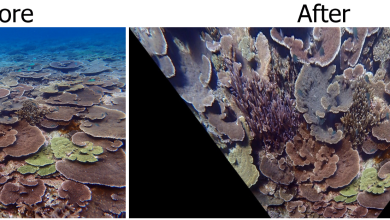Initiative in the Water
For decades, Florida Tech has worked to better understand the Indian River Lagoon. New research projects, as well as a new building, continue the focus on improving the overall health of the lagoon.
Stretching 156 miles along Florida’s eastern coast spans a waterway that is home to 2,100 different species of plants and more than 2,200 animal species. This estuary is comprised of the Mosquito Lagoon, Banana River and Indian River.
From Ponce de León Inlet in Volusia County to Jupiter Inlet in Palm Beach County, this collective known as the Indian River Lagoon (IRL) is a place of oceanic biodiversity, community identity and unquestionable beauty.
The lagoon is also troubled, battered by forces of nature and humans—rarely, at least in recent memory, at its pristine and healthy best.
That’s why for more than 40 years, Florida Tech faculty and students have worked to better understand the Indian River Lagoon. It has struggled to remain healthy, marred by increases in algal blooms and fish kills and the decimation of oyster and seagrass populations. This has spurred lagoon supporters from labs and living rooms to explore multiple approaches to restoring the IRL’s health, as scientists and lawmakers investigate the effectiveness of different actions and procedures.
Over these multiple decades of research, Florida Tech has examined various ways that may help improve the lagoon’s water quality. Much like the diverse system itself, this work will take various efforts from diverse fields to succeed.
Restoring Lagoon Inflows
Florida Tech’s Restore Lagoon Inflow research project is a multiyear study funded by the State of Florida through the Florida Department of Education in support of a local project appropriation secured by the Brevard County legislative delegation. The project is studying the possible effects of enhanced seawater exchange between the IRL and coastal ocean, and related research is expected to provide critical data analysis to help policymakers, agencies and stakeholders determine if this seawater exchange via mechanical pumping or other mechanism should be considered as a viable compliment to ongoing restoration activities.
“We do not have a preconceived idea of what the benefits, if any, of inflow will be,” said Jeff Eble, research assistant professor in ocean engineering and marine sciences and one of several faculty members involved in the project. “We are investigating the impact of inflow, negative and positive, on the water quality, habitats and resident species of the Banana River. Can inflow help restore the health and vitality of the Banana River system, which would translate to benefits for everyone who uses the river? And can inflow provide these benefits without significant negative impacts? These are the questions we are seeking to answer.”
We are investigating the impact of inflow, negative and positive, on the water quality, habitats and resident species of the Banana River.
—Jeff Eble, Research Assistant Professor
As the government and developers have hardened the shores and altered habitats to support new development and protect existing development, water exchange among lagoon basins and between the lagoon and the ocean has become restricted. That decrease in water circulation has led to increased accumulation of nutrients, which promotes more frequent harmful algal blooms and related declines in lagoon health.
“We have this established ecosystem, for better or worse, that is disconnected from the coastal ocean,” said Gary Zarillo, a professor in ocean engineering and marine sciences who is leading the extensive modeling research in the lagoon inflow project. “Under more natural conditions, before we had a human-natural system coupling, routine overwashes at tidal inlets would open up and stay in place for a while, migrate along shore, rework the barrier island, close and then a time after that there might be another cycle.”
The findings in Phase I highlighted well-documented patterns in the lagoon and estuaries, including impacts of declining water quality on resident species and habitats.
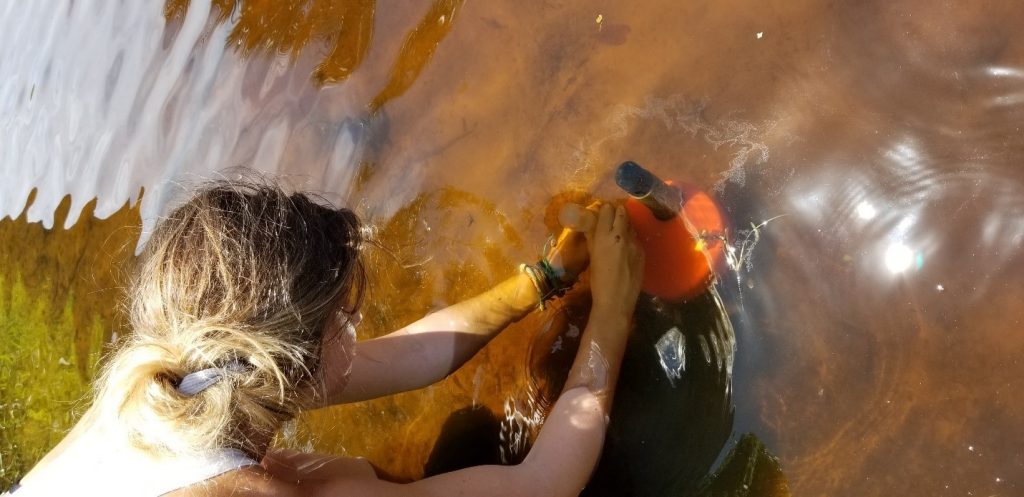
Student researcher Abbey Gering collects water samples from a benthic chamber used to measure nutrient fluxes and sediment oxygen demand.
Researchers also found high natural variability in temperature and salinity both among and within lagoon sites, which reflects the dynamic nature of estuarine ecosystems.
The team investigated inflow possibilities via physical and geochemical modeling and found that all modeled pumping scenarios reduce water residence time—the average time water is retained in a specific area—and that residence time decreased with increased pumping volume. Pumping was also predicted to result in an overall small decrease in water temperature, a small increase in salinity and more stable dissolved oxygen concentration.
The team also conducted baseline field surveys to track seagrasses, drift algae and benthic inverts and to study phytoplankton response to pumping.
Digging in the Data
Field sampling yielded not only useful data but invaluable research experience for students such as Austin Anderson. Anderson, a master’s student in marine biology, worked with oceanography and environmental sciences professor Kevin Johnson’s lab on benthic and seagrass surveys, among other duties.
“When I started working the project, I had to be taught every aspect of the research we were conducting,” Anderson said. “There is some stuff that is hard to teach in a course because the curriculum doesn’t always cover it or line up in a way that calls for it to be taught. This is why research is important to get involved in.”
The lagoon, he added, provides an opportunity for research in the university’s backyard that students elsewhere may not get to experience.
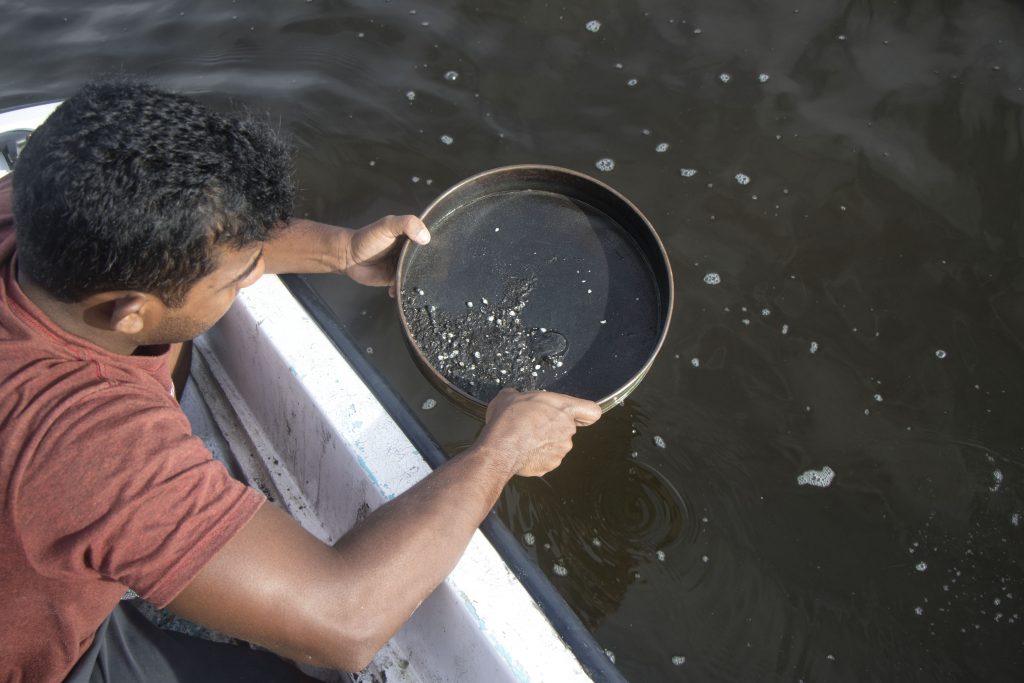
Student researcher Nayan Mallick collects infauna data by using sediment grabs and sieving the mud/sand.
“We get to study what has been regarded as one of the most biodiverse ecosystems in North America for a long time, in a way that seeks to restore the habitats that helped make it so diverse,” Anderson said. “That, to me, is something that is every research scientist’s dream—to conduct research that can help restore an ecosystem to the haven of biodiversity it once was and still has the potential to be.”
First phase data highlighted the need for a small, temporary inflow pilot system to better characterize pumping impacts, with the location of the pilot pumping project being most effective at or near the locks in Port Canaveral. That is due in part to the relative lower cost and ease of access for a temporary pumping system as well as the existing exchange of seawater from port access at the locks. Additionally, the Banana River portion of the lagoon, where the Port is located, has been a “hot spot” for harmful algae blooms and declining water quality, so studying the impact of pumping in that area could yield highly beneficial results.
“One of the primary goals of phase 1 was to identify candidate research test sites and determine which location would be best for transporting nutrients out of regions in the lagoon that have high retention times and correspondingly high nutrient loads, which lead to harmful algal blooms,” Eble said.
Phase 2 of the project, which received state funding in late 2020 involves several elements that build on findings from the first phase: integrating models to better resolve the influences of different inflows on the Banana River; increasing baseline data collection to inform project feasibility and support the proposed pilot study; incorporating feedback from stakeholders and permitting agencies; and investigating alternative pilot designs.
That is every research scientist’s dream—to conduct research that can help restore an ecosystem to the haven of biodiversity it once was and still has the potential to be.
Austin Anderson, Marine Biology Master’s Student
Working for Coastal Communities
Whether increased inflow may help in the lagoon’s water quality will depend on nutrient fate—how nutrients are transported, cycled and ultimately removed from the system.
“The initial assumptions that people make is that this is simple: You pump good water in, and bad water flows out. It’s much more complicated than that,” said Austin Fox, assistant professor of ocean engineering and marine sciences who is leading the geochemical aspects of the project. “How do those changes influence other aspects of water quality? You have all of these processes occurring within the system, so you can’t think of this as you add some water to your Kool-Aid and it is quickly diluted. Think of it as you have some Kool-Aid that has some powder at the bottom, and as you add more water it’s not immediately diluting it.”
Ultimately, the goal of the project is to determine whether enhanced circulation is a viable complement to a range of conservation activities that will be needed to restore the lagoon to full health.
In addition to Eble, Zarillo and Fox, Florida Tech faculty members Jesse Blanchard, Ashok Pandit, Jonathan Shenker, Ralph Turingan, Robert Weaver and John Windsor are involved in the lagoon inflow research project.

Student researcher Caleb Lodge prepares to deploy an acoustic Doppler current profiler in the Banana River.
Florida Tech’s work on the lagoon not only has the potential to assist the local region, but other communities as well.
“Coastal water quality is one of the most ubiquitous problems of coastal areas around the globe,” Fox said. “We like to look at the lagoon as this microcosm where we can study these global processes, and it’s easy to access and has a huge variety of environments.”
For ocean engineering and marine sciences head Rich Aronson, it’s important to emphasize the IRL’s problems will not be solved immediately nor with one solution. However, the work the university is doing not only provides educational opportunities for students but contributes “to our overall understanding of environmental threats and solutions.”
“There’s an unfortunate tendency to think if your contribution to science or your individual action on an environmental problem is small that it doesn’t matter, but the things we do add up,” he said.
Bags of Bottlecaps
Assistant professor Austin Fox and graduate oceanography student Abbey Gering are working on a novel IRL water treatment that will feature mesh bags filled with bottle caps. The bags will be placed in strategic locations within the lagoon to allow “good” bacteria to grow on them. These good bacteria can convert and remove excess nitrogen from the lagoon through a process called denitrification, helping clean the water and contributing to the prevention of harmful algal blooms.
The bags can be moved to other parts of the lagoon, with the accumulated bacteria helping improve water quality in whichever areas they are needed.
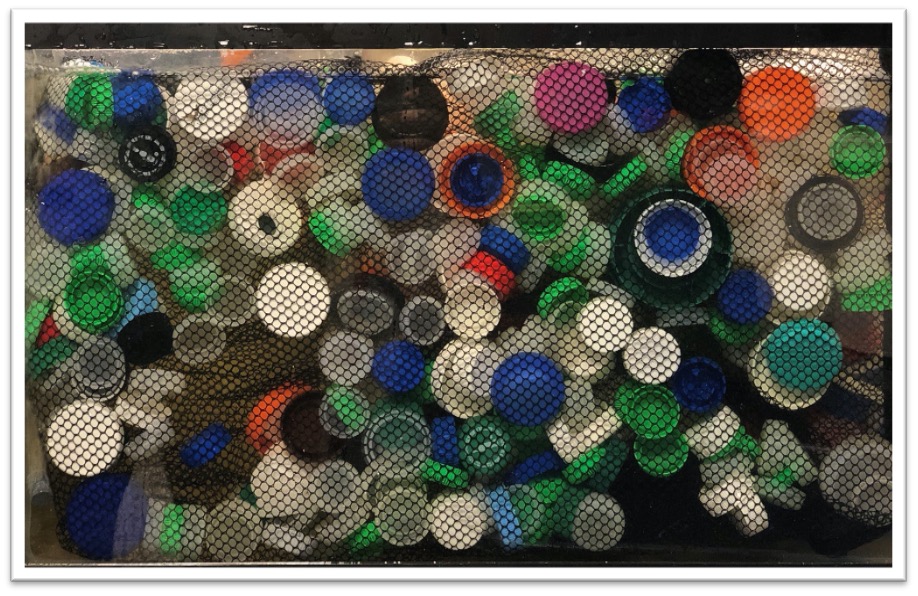
This doesn’t mean that tossing your bottle caps into the lagoon will lead to cleaner water, Fox and Gering emphasized. The cap-filled bags will work best in ideal conditions, where the bacteria would thrive with an abundance of nitrogen and just the right amount of oxygen, leading to biochemical reactions that could in turn lead to improved water quality.
This project stemmed from testing if adding oxygen to the lagoon would improve water quality. While there were promising results with this process, known as aeration, Fox felt like the results could be better if they had the right bacterial communities.
This is because the degraded lagoon sediment where the water-cleaning bacteria would grow was not ideal for those types of organisms. It was then that Fox examined whether they could develop a place for the bacteria to live, which led to Gering using bioballs—plastic balls used in home aquariums—to provide a place for that growth. Those healthy bacteria helped to get rid of the nitrogen, but Fox and Gering wanted to find a sustainable and cost-effective way to carry this finding forward.
The project has had the fringe benefit of strengthening community connections. In addition to reaching out to students about gathering and providing bottle caps, the team is working with businesses such as the Brevard Zoo and local coffee shops to collect the plastic tops.
“Once you start collecting them, you start realizing how many bottle caps you use daily,” Gering said. “It’s a good way to get the community more aware of their use, while also reusing it for something that may help water quality.”
Support Through Passion

Lawrence “Larry” Mertens had a passion for underwater scientific research and marine life. He and his wife, Margarete, were avid scuba divers. Larry also enjoyed underwater photography, capturing beautiful color photographs of fish and corals both at night and during the day.
Larry became Florida Tech’s first marine biology instructor through the request of his friend Jerome Keuper, Florida Tech’s founding president, who was starting up the program. Mertens designed and ran the first summer field course in the Bahamas for underwater photography and was later an instructor for the university’s first course in optical oceanography. He was also the first Florida Tech faculty member to author a college-level textbook, on in-water photography.
As Mertens grew to become a major benefactor for the university, he used his passion for the water as a guide for some of his largess. In 2014, the Lawrence and Margarete Mertens Endowed Fellowship Fund was established, which supports graduate students enrolled in the College of Engineering and Science through a $1 million gift. In 2017, they established the Lawrence and Margarete Mertens Building Fund, another $1 million gift to support the development, design and construction of a state-of- the-art facility at the Ralph S. Evinrude Marine Operations Center at the mouth of Crane Creek on Melbourne Harbor.
The building will assist researchers in their Indian River Lagoon (IRL) improvement efforts and provide a premier educational experience for students as they get hands-on experience with the lagoon. While Lawrence Mertens passed away in December of that year and Margarete Mertens passed away in May 2018, their endowment for the building was a final way of giving to their passion. Currently, land zoning and building renderings are in production, with a goal of opening the building in 2022.
The idea of assisting IRL scientific research efforts was something that Mertens was interested in prior to his passing. Through his educational, diving and underwater photography experience, Mertens saw the benefits of clean water, not only from a biological standpoint, but from a human interest one as well.
The IRL water quality work being done at Florida Tech was some of the research the Mertenses enjoyed learning more about during their trips to campus.
“This building is part of the legacy of Larry and Margarete, and we are excited to see the work that will come out of it to help the Indian River Lagoon,” university President Dwayne McCay said.
This piece was featured in the winter 2021 edition of Florida Tech Magazine.

